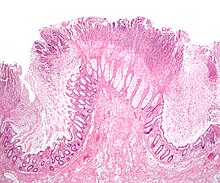
Back تضخم القولون السمي Arabic Toxisches Megakolon German Megacolon tóxico Spanish مگاکولون توکسیک Persian Toksinen megakoolon Finnish Mégacôlon toxique French Megacolon tossico Italian Ostre rozdęcie okrężnicy Polish Toksik megakolon Turkish Токсичний мегаколон Ukrainian
| Toxic megacolon | |
|---|---|
| Other names | Megacolon toxicum |
 | |
| Micrograph of pseudomembranous colitis, a cause of toxic megacolon. H&E stain. | |
| Specialty | Gastroenterology |
| Symptoms | Swelling of the belly, Pain in the belly, Fever, Rapid heart rate, Shock, Diarrhea.[1] |
| Complications | Septic shock, perforation of the colon |
| Risk factors | Chronic bowel disease |
| Prognosis | Fatal without treatment |
Toxic megacolon is an acute form of colonic distension.[2] It is characterized by a very dilated colon (megacolon), accompanied by abdominal distension (bloating), and sometimes fever, abdominal pain, or shock.
Toxic megacolon is usually a complication of inflammatory bowel disease, such as ulcerative colitis and, more rarely, Crohn's disease, and of some infections of the colon, including Clostridioides difficile infections, which have led to pseudomembranous colitis. Other forms of megacolon exist and can be congenital (present since birth, such as Hirschsprung's disease). It can also be caused by Entamoeba histolytica and Shigella. It may also be caused by the use of loperamide.
- ^ "Toxic Megacolon". Johns Hopkins Medicine. 19 November 2019. Retrieved 15 March 2023.
- ^ "Toxic megacolon" at Dorland's Medical Dictionary